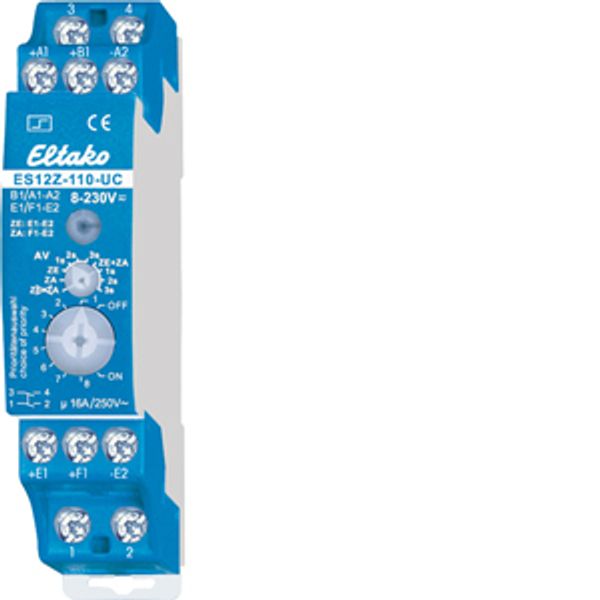Inscrivez-vous pour débloquer vos prix B2B exclusifs et commencez vos achats. Inscrivez-vous maintenant!
Impulse switch, 1 NO contact + 1 NC contact 16A
Commande uniquement
Prix (hors TVA):
40,62 €
EAN: 4010312107683
MPN: 21110601
Colis: 1
Délai de livraison estimé à notre entrepôt (environ):
4-6 weeks
Technical Information
| État de l’article | Nouveau |
| Nom du fabricant | Impulse switch, 1 NO contact + 1 NC contact 16A |
| Marque | ELTAKO |
| Catégories |
Latching Relays
|
| Pays d’origine* | CN |
| * The actual country of origin may differ depending on the delivery batch. To confirm the specific country of origin, please contact your account manager. | |
| Code du système harmonisé | 8536 5080 00 |
| Méthode de montage | Rail DIN |
| Fonction | Electronique pour contrôle centralisé |
| Tension de contrôle 1 | 8-230 V |
| Type de tension de commande 1 | AC/DC |
| Type de tension d'alimentation | AC |
| Tension d'alimentation | 250 V |
| Courant nominal de commutation | 16 A |
| Nombre de contacts comme contact normalement ouvert | 1 |
Détails d’emballage
| Niveau d’emballage 1 | 4010312107683, 4010312107683 |
| Niveau d’emballage 2 | 4010312107683 |
| Niveau d’emballage 3 | 4010312107683 |
Autres données techniques
| Profondeur d'encastrement | 58 mm |
| Largeur en nombre d'espacements modulaires | 1 |
| Tension de commande 2 | 8-230 V |
| Tension de contrôle de la fréquence 1 | 50 Hz |
| Tension de commande de fréquence 2 | 50 Hz |
| Adapté au fonctionnement manuel | No |
| Courant de commutation maximal (cos phi = 0,6) | 4 A |
| Charge max. lampe à incandescence | 2000 W |
| Charge max. lampe fluorescente | 1000 VA |
| Charge max. lampe fluorescente (circuit Duo) | 1000 VA |
| Charge maximale lampe fluorescente (parallèle compensée) | 500 VA |
| Nombre de contacts comme contact normalement fermé | 1 |
| Nombre de contacts comme contact inverseur | 0 |
Téléchargements
Description
1 NO contact + 1 NC contact potential free 16A/250V AC. 230V LED lamps up to 200W, incandescent lamp load up to 2000W. Standby loss 0.03–0.4 watt only. Central control priorities selectable. Modular device for DIN-EN 60715 TH35 rail mounting. 1 module = 18mm wide, 58mm deep. State-of-the-art hybrid technology combines advantages of nonwearing electronic control with high capacity of special relays. Local universal control voltage 8 to 230V UC. In addition control inputs 8 to 230V UC central ON and central OFF, electrically isolated from the local input. Supply voltage same as the local control voltage. Very low switching noise. Glow lamp current starting at 110V control voltage up to 50mA in positions 1 to 3 and 5 to 7 of the rotary switch. By using a bistable relay coil power loss and heating is avoided even in the on mode. The switched consumer may not be connected to the mains before the short automatic synchronisation after installation has terminated. Maximum current across both contacts 16A for 230V. Contact position indication with LED. This starts blinking after 15 seconds in case of an inhibited pushbutton, not in position 4+8 of the rotary switch. With the upper rotary switch this impulse switch can be partly or completely excluded from central control: ZE+ZA = Central ON and Central OFF are active. You can select a response delay of 0, 1, 2 or 3 seconds for Central ON. ZE = Only Central ON is active. You can select a response delay of 0, 1, 2 or 3 seconds. ZA = Only Central OFF is active. ZE+ZA = No central control is active. The lower rotary switch sets several priorities. These determine which other control inputs are inhibited as long as onother control input is excited permanently. Furthermore, here it is decided if the switch position should be kept or not after a power failure: In positions 1 to 4 of the rotary switch the switch position remains unchanged, in positions 5 to 8 it is switched off. Incoming central commands are executed immediately after the powersupply returns. OFF = Permanent OFF, ON = Permanent ON. 1 and 5 = No priority. Also if central control inputs are excited permanently, it is possible to operate the device by pushing a local push-button. The last central command is executed. This is the setting ex factory. 2 and 6 = Priority for central ON and OFF. Local pushbuttons are temporarily inhibited. However, continuous excitation central OFF has priority over continuous excitation central ON. 3 and 7 = Priority for central ON and OFF. Local push-buttons are temporarily inhibited. However, continuous excitation central ON has priority over continuous excitation central OFF. 4 and 8 = Priority for permanently excited local push-button. In the meantime central commands are not executed. In these positions a glow lamp current is not permitted.

